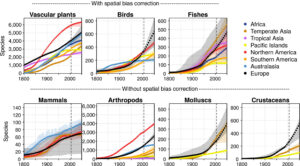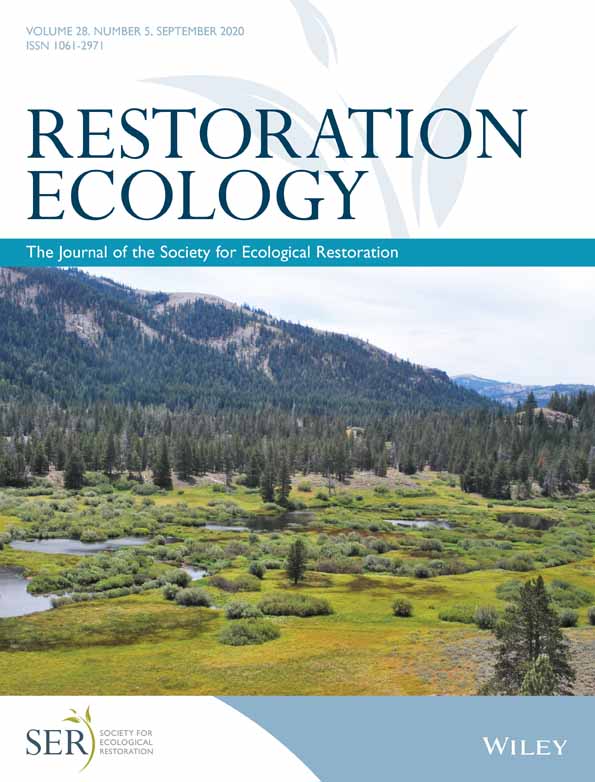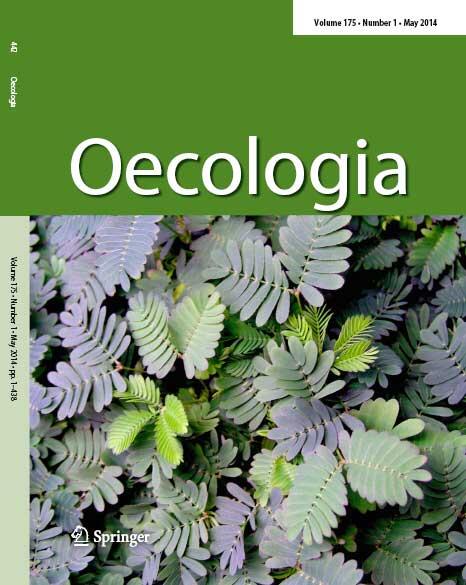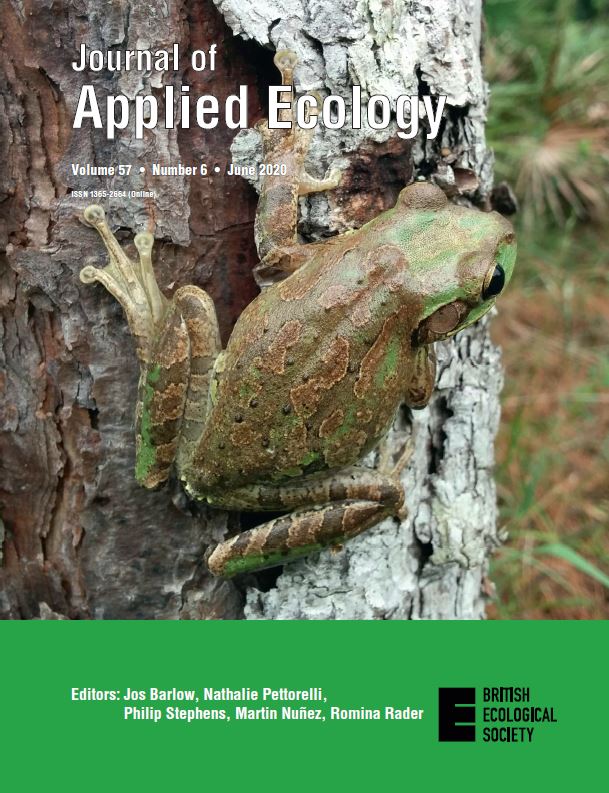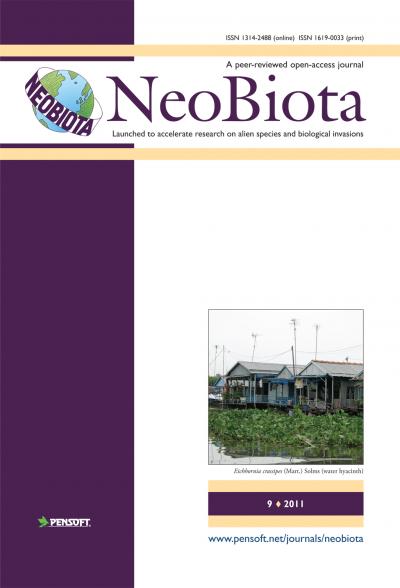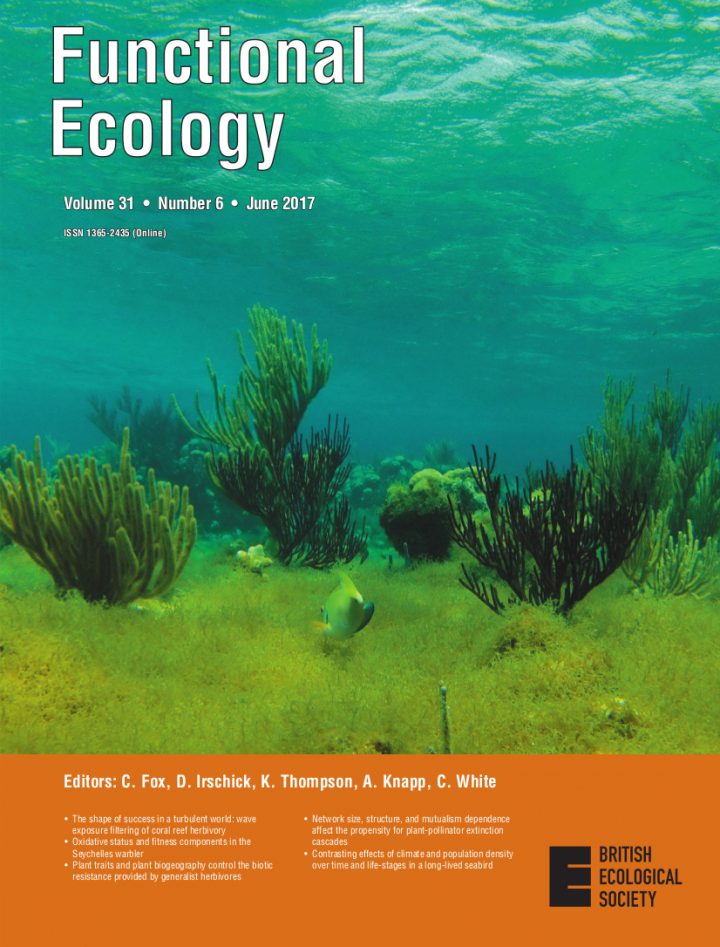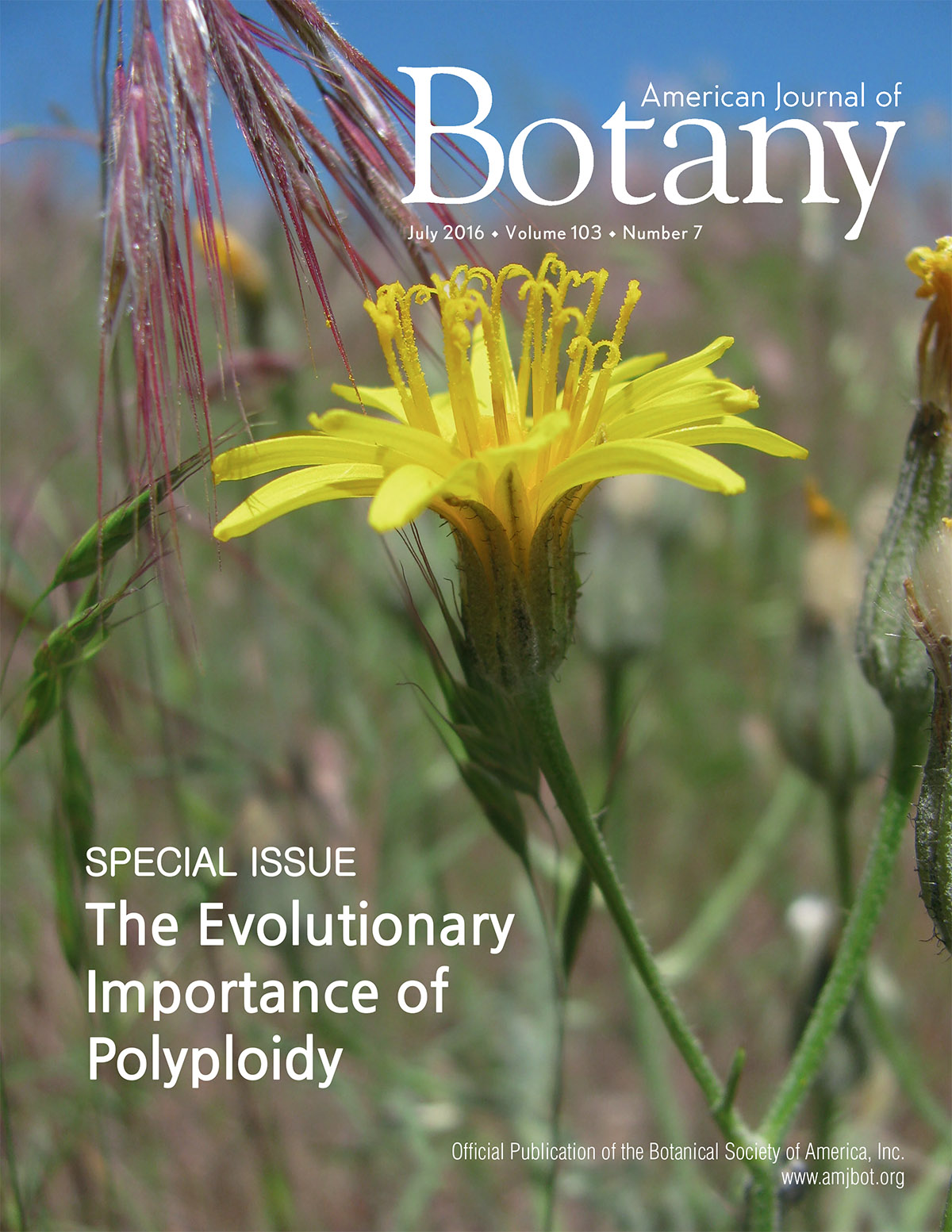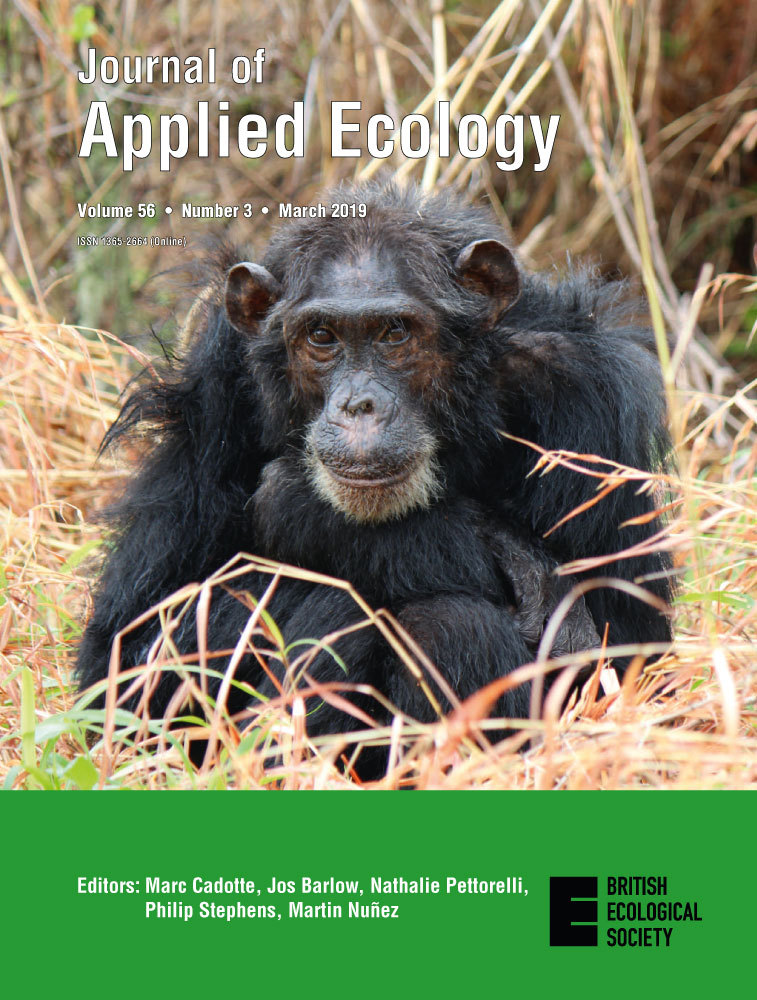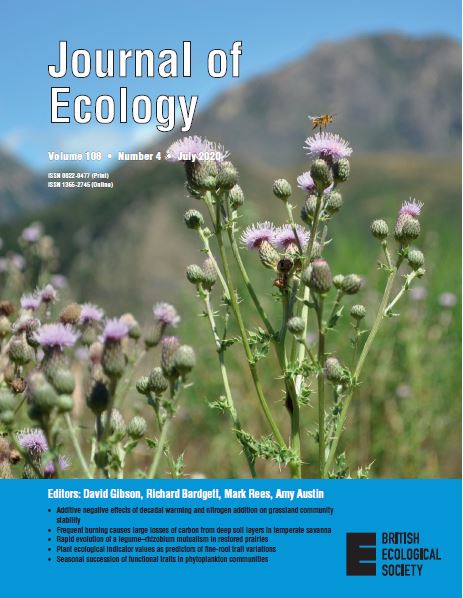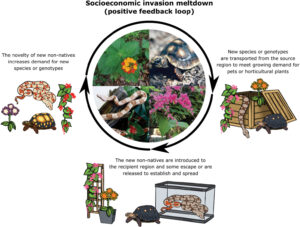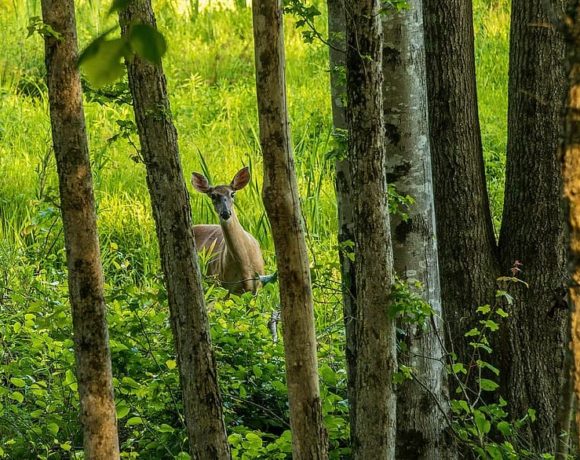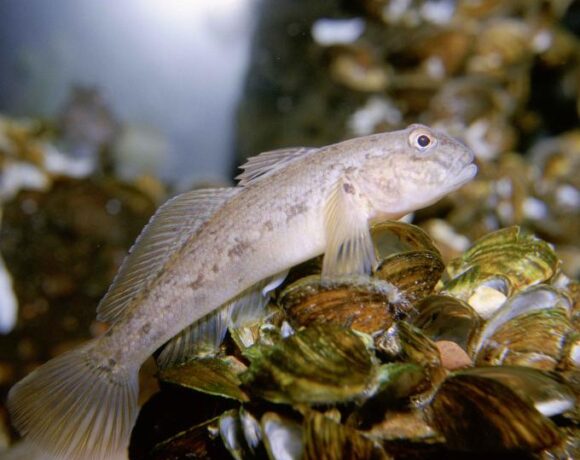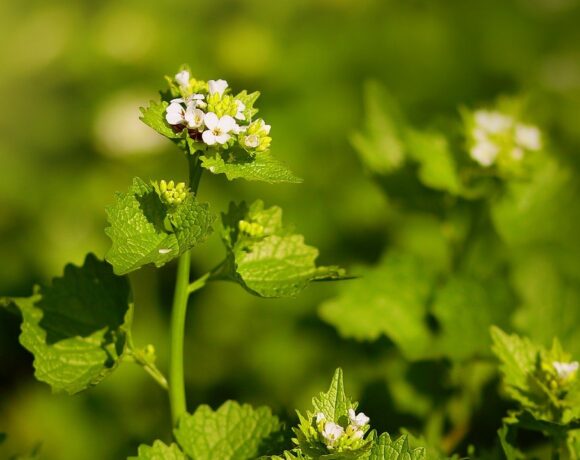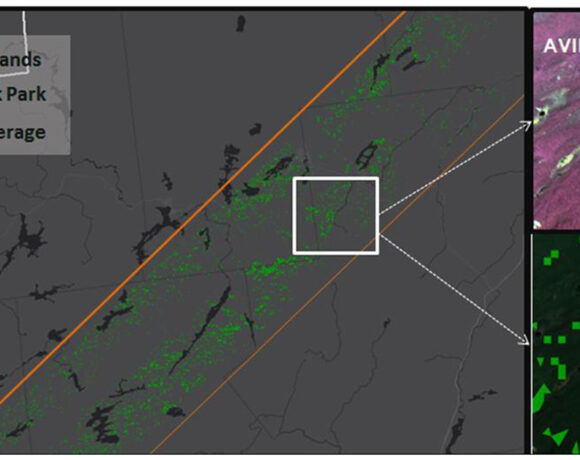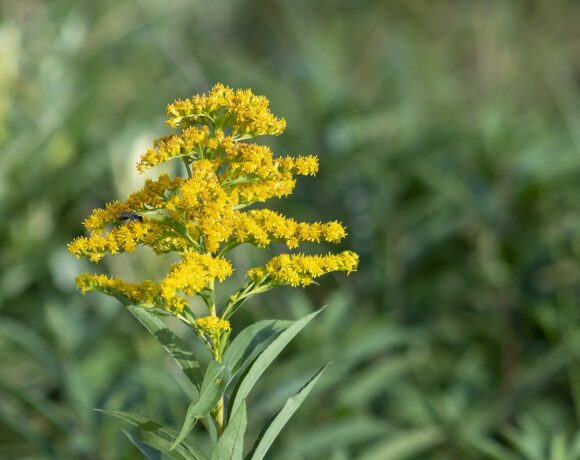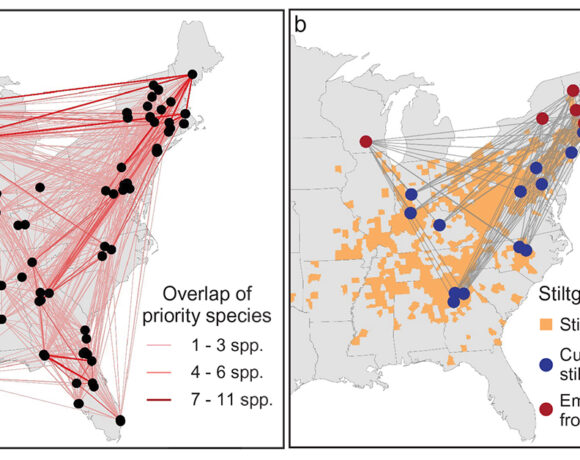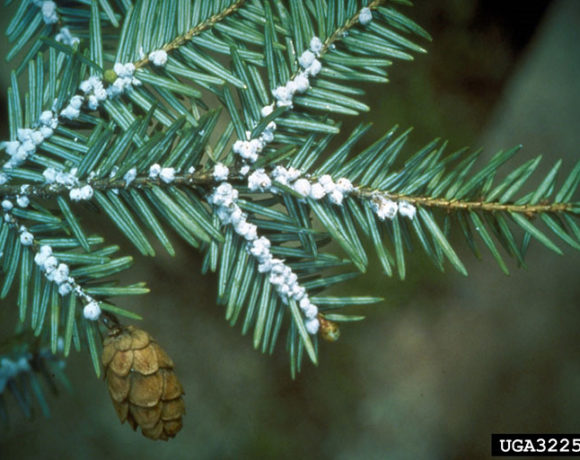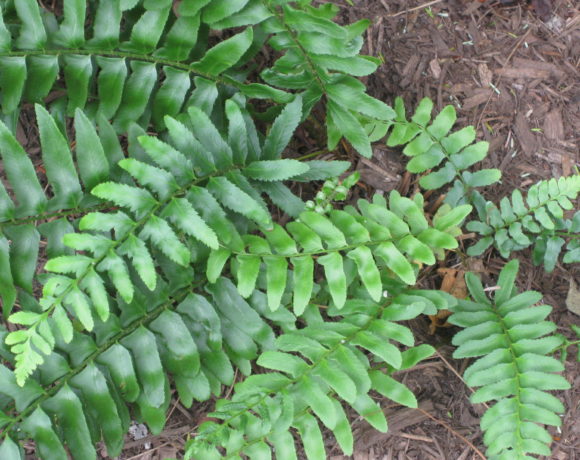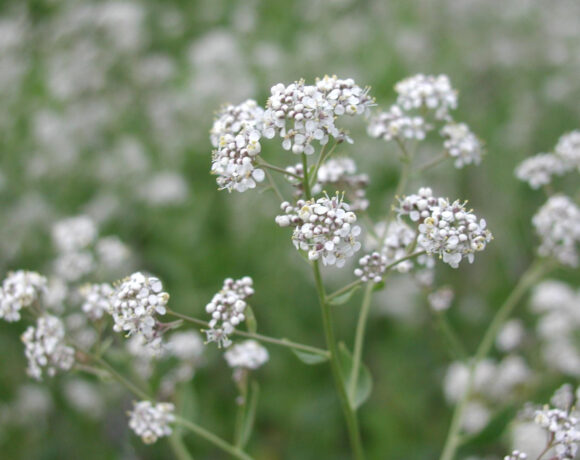To create this research digest, we scan over two dozen ecology journals for papers on 1) invasive species present in New York State, or the Northeast region, 2) theoretical concepts or models which may have implications for management in New York State, or 3) economic, social, or ecological impacts of invasive species on a regional or global scale. The goal is to help managers and partners across the state of New York to more easily keep up to date on current research.
Several papers listed each month are open access, and anyone can view entire manuscripts. If an article you would like to read is not available through your institution, you can often contact lead or corresponding authors to receive a copy. If you are unable to obtain a paper this way, please contact us and we are happy to work with you to get you access.
Rapid amphibian community recovery following removal of non-native fish from high mountain lakes
View Article Biological Conservation
Abstract
Amphibians of high mountain lakes face many threats related to global change, including novel pathogens, development, climate change and overexploitation. However, the foremost threat is the presence of non-native fish. One of the objectives of the LIFE+ LIMNOPIRINEUS project (2014–2019) was the recovery of protected amphibian communities (including the endemic Calotriton asper) in eight naturally fishless Pyrenean high mountain lakes, by controlling or eradicating non-native trout or minnows. During the summer months of 2015 to 2019, we removed 95–100% of the fish present in these lakes, and monitored changes in their amphibian populations, as well as surveyed 56 nearby control lakes with or without fish. We found rapid natural recovery of amphibian communities as fish removal work progressed. The fish-removal lakes achieved typical richness figures for the area one year after fish removal began, and typical species abundances after three years (with the only exception of Rana temporaria). We documented a total of 16 colonisation events, all by amphibian species from the same valley. The two earliest colonisation events were observed in the year in which fish removal began, with eight events the following year. The lack of colonisation from nearby valleys in the study period highlights the crucial role of nearby residual populations not affected by human impacts. We show that whole amphibian communities from high mountain lakes recover rapidly after eliminating or reducing non-native fish, proving that this is a powerful tool to improve the conservation status of endangered amphibians.
Influence of reproductive biology on establishment capacity in introduced Hymenoptera species
View Article Biological Invasions
Abstract
Introduced species face numerous biological barriers before they can establish in a new environment. Understanding how they overcome these obstacles is crucial for the development of effective risk assessment and regulation. Reproductive biology is known to influence establishment capacity in plants and is widely used for risk assessment. This biological field should receive more attention, and particularly in the case of insects, as they display a wide range of reproductive traits and have a great impact on the economy and environment. Among insects, the order Hymenoptera is of interest for its diversity, both in terms of reproductive traits and introduction history, as invasive species and biological control agents. We review the main reproductive strategies of Hymenoptera, spanning parthenogenesis, sex determination, reproductive parasites and mating strategies, and evaluate their effect on invasive potential. For instance, thelytoky could decrease the strength of Allee effects while Arrhenotoky could increase adaptive potential. A species with complementary sex determination could be more affected by inbreeding than other species, while paternal genome elimination could lead to high levels of homozygosity. Finally, some reproductive behaviours could decrease inbreeding, facilitate mate location or adaptation by encouraging admixture. The two invasive species Apis mellifera scutellata and Leptocybe invasa and the biocontrol agent Aphidius ervi serve as case studies to illustrate the effect of reproductive traits on species capacities to become established in a new area.
Zebra mussel invasion of Texas lakes: estimating dispersal potential via boats
View Article Biological Invasions
Abstract
Invasive zebra mussels (Dreissena polymorpha) pose both a significant economic and environmental threat to aquatic systems yet there are currently no effective methods for achieving large-scale eradication. As a result, predicting and preventing their spread play a critical role in management efforts. Zebra mussels were first found in Texas in 2009 and, as of November 2019, have invaded 39 lakes across five river basins. Prior state-specific risk-assessments have been solely based on habitat suitability and have not considered dispersal potential. We developed a water body specific, constrained gravity model incorporating habitat suitability and dispersal potential to predict potential future invasion patterns. We examined the relative importance of habitat suitability, lake attractiveness, the relative risk of different boater types, and the impact of boater compliance with recommended prevention measures. Differences in lake attractiveness resulted in different boater dispersal patterns but the impact on projected lake invasions were reduced by variation in habitat suitability. The model projected zebra mussels to be mainly limited by habitat conditions in east Texas and by dispersal in west Texas. Most lakes in central Texas were projected to become invaded in the near future unless boater compliance with preventive management was high.
Predicting range expansion of invasive species: Pitfalls and best practices for obtaining biologically realistic projections
View Article Diversity and Distributions
Abstract
Aim: Species distribution models (SDMs) are widely used to forecast potential range expansion of invasive species. However, invasive species occurrence datasets often have spatial biases that may violate key SDM assumptions. In this study, we examined alternative methods of spatial bias correction and multiple methods for model evaluation for seven invasive plant species. Methods: We employed bias‐correction measures for both occurrence sampling and background sampling inputs in a factorial design for Maxent resulting in six potential models for each species. We evaluated our models for complexity, model fit and using commonly employed evaluation metrics: AUC, partial AUC, the continuous Boyce index and sensitivity. We then developed a structured process for model selection. Results: Models developed without occurrence or background bias correction often were overly complex and did not transfer well to expanding range fronts. Conversely, models that employed occurrence and/or background bias‐correction measures were less complex, had better AICc scores and had greater projection into incipient areas. These simpler models were also more likely to be selected when evaluated using a process that integrated multiple evaluation metrics. We found that invasion history (e.g. established versus incipient) was associated with the effectiveness of spatial bias correction techniques. Main Conclusions: While challenges exist in building climate‐based correlative species distribution models for invasive species, we found that methods relying on maximizing AUC performed poorly for invasive species. We advocate for the use of multiple and diverse metrics for model evaluation. Users of species distribution models need to incorporate explicit consideration of model discrimination, model fit and model complexity into their decision‐making processes if they are to build biologically realistic models.
The effects of nutrient enrichment and invasive mollusks on freshwater environments
View Article Ecological Applications
Abstract
The effects of an invasive species on the environment can be altered by anthropogenic activities such as nutrient pollution or the presence of additional invasive species with similar or unique traits. Using experimental mesocosms, we tested the separate and combined effects of three invasive mollusks (zebra mussels, Asian clams, and banded mystery snails) on freshwater environments in nutrient‐poor and nutrient‐enriched conditions. We predicted that in nutrient‐poor conditions, single mollusk species would reduce the abundance of algae and zooplankton, but nutrient enrichment would mitigate these effects. Regardless of nutrient additions, paired bivalve species would reduce phytoplankton and zooplankton abundance, increasing periphyton biomass. Bivalves and snails paired together would reduce periphyton, phytoplankton, and zooplankton compared to communities with paired bivalve species. Finally, nutrient enrichment would increase the survival or biomass of paired bivalves and snails. Single, paired, and three co‐occurring invasive mollusks did not affect algae or zooplankton abundance. Banded mystery snails reduced nutrient concentrations in high‐nutrient conditions more than other invasive species, but the reduced nutrients did not affect algal abundance. Paired invasive species did not affect the survival or biomass of other invasive species. Nutrient enrichment increased the biomass of zebra mussels and mystery snails, but not Asian clams. Additionally, zebra mussel reproduction increased in the high‐nutrient treatment when banded mystery snails were present, but not when all three species were together. We conclude that human‐induced trophic states might determine the effects that single and multiple invasive species have in freshwater environments.
Projecting the continental accumulation of alien species through to 2050
View Article Global Change Biology
Abstract
Biological invasions have steadily increased over recent centuries. However, we still lack a clear expectation about future trends in alien species numbers. In particular, we do not know whether alien species will continue to accumulate in regional floras and faunas, or whether the pace of accumulation will decrease due to the depletion of native source pools. Here, we apply a new model to simulate future numbers of alien species based on estimated sizes of source pools and dynamics of historical invasions, assuming a continuation of processes in the future as observed in the past (a business‐as‐usual scenario). We first validated performance of different model versions by conducting a back‐casting approach, therefore fitting the model to alien species numbers until 1950 and validating predictions on trends from 1950 to 2005. In a second step, we selected the best performing model that provided the most robust predictions to project trajectories of alien species numbers until 2050. Altogether, this resulted in 3,790 stochastic simulation runs for 38 taxon–continent combinations. We provide the first quantitative projections of future trajectories of alien species numbers for seven major taxonomic groups in eight continents, accounting for variation in sampling intensity and uncertainty in projections. Overall, established alien species numbers per continent were predicted to increase from 2005 to 2050 by 36%. Particularly, strong increases were projected for Europe in absolute (+2,543 ± 237 alien species) and relative terms, followed by Temperate Asia (+1,597 ± 197), Northern America (1,484 ± 74) and Southern America (1,391 ± 258). Among individual taxonomic groups, especially strong increases were projected for invertebrates globally. Declining (but still positive) rates were projected only for Australasia. Our projections provide a first baseline for the assessment of future developments of biological invasions, which will help to inform policies to contain the spread of alien species.
Genetic variation in resistance and high fecundity impede viral biocontrol of invasive fish
View Article Journal of Applied Ecology
Abstract
Common carp Cyprinus carpio is one of the top global invasive vertebrates and can cause significant ecological damage. The Australian Government’s National Carp Control Program (NCCP) proposes to release Koi herpesvirus (KHV) to eradicate feral carp in one of the largest ecological interventions ever attempted. Ecological and human health risks have been highlighted regarding the release of a highly pathogenic viral biocontrol for an aquatic species. The efficacy of KHV has also been questioned, and it has not been demonstrated to produce lasting population reductions. We developed an individual‐based model (IBM) to examine the ecological and evolutionary response of a carp population after KHV release. This simulated the interaction between fish life history, viral epidemiology, host genetic resistance and population demography to critically evaluate the impact of KHV release under optimal conditions and a ‘best‐case scenario’ for disease transmission. KHV will rarely result in prolonged reductions or population extinctions. Crucially, realistic scenarios result in a rapidly rebounding population of resistant individuals. Additional measures aimed to reduce carp population recovery rate (e.g. with genetic engineering) require rapid efficacy to significantly reduce carp numbers alongside KHV. Fish fecundity has an overwhelming influence on viral efficacy as a biocontrol agent when combined with genetic resistance within a population. A high probability of population extinction is only met when carp fecundity is reduced to 1% of biological observations. Synthesis and applications. We use an individual‐based model to evaluate the efficacy of Koi herpesvirus biocontrol in Common Carp, and find that high host fecundity combined with genetic resistance results in rapid population rebound after initial large fish kills. Biocontrol approaches relying on natural selection lose efficacy over successive generations as resistance genes increase in frequency. Given the intense logistical effort and risks to ecosystems and human health associated with large fish kills after viral release, we suggest that sustained manual removal, alongside ecological restoration to favour recovery of native species, provides a risk‐free approach to reducing populations.
The importance of assessing positive and beneficial impacts of alien species
View Article Neobiota
Abstract
Extensive literature is available on the diversity and magnitude of impacts that alien species cause on recipient systems. Alien species may decrease or increase attributes of ecosystems (e.g. total biomass or species diversity), thus causing negative and positive environmental impacts. Alien species may also negatively or positively impact attributes linked to local human communities (e.g. the number of people involved in a given activity). Ethical and societal values contribute to define these environmental and socio-economic impacts as deleterious or beneficial. Whilst most of the literature focuses on the deleterious effects of alien taxa, some recognise their beneficial impacts on ecosystems and human activities. Impact assessment frameworks show a similar tendency to evaluate mainly deleterious impacts: only relatively few, and not widely applied, frameworks incorporate the beneficial impacts of alien species. Here, we provide a summary of the frameworks assessing beneficial impacts and briefly discuss why they might have been less frequently cited and applied than frameworks assessing exclusively deleterious impacts. Then, we review arguments that invoke a greater consideration of positive and beneficial impacts caused by alien species across the invasion science literature. We collate and describe arguments from a set of 47 papers, grouping them in two categories (value-free and value-laden), which span from a theoretical, basic science perspective to an applied science perspective. We also provide example cases associated with each argument. We advocate that the development of transparent and evidence-based frameworks assessing positive and beneficial impacts might advance our scientific understanding of impact dynamics and better inform management and prioritisation decisions. We also advise that this development should be achieved by recognising the underlying ethical and societal values of the frameworks and their intrinsic limitations. The evaluation of positive and beneficial impacts through impact assessment frameworks should not be seen as an attempt to outweigh or to discount deleterious impacts of alien taxa but rather as an opportunity to provide additional information for scientists, managers and policymakers.
Exploring the potential of using priority effects during ecological restoration to resist biological invasions in the neotropics
View Article Restoration Ecology
Abstract
Manipulating plant order of arrival, a process that creates priority effects, may be an unexplored powerful tool to hinder the establishment of invasive non‐native plants in sites under restoration. Knowledge and experimental studies on priority effects in the neotropics are scarce. Here, we propose a research agenda that investigates whether manipulating plant order of arrival can create priority effects in the neotropics, and if this strategy can be used to avoid the spread of undesired species in restoration projects. We also describe our view on expanding existing knowledge on priority effects to the neotropics and identifying key questions for future research.
Capitalizing on opportunistic citizen science data to monitor urban biodiversity: A multi-taxa framework
View Article Biological Conservation
Abstract
Monitoring urban biodiversity is increasingly important, given the increasing anthropogenic pressures on biodiversity in urban areas. While the cost of broad-scale monitoring by professionals may be prohibitive, citizen science (also referred to as community science) will likely play an important role in understanding biodiversity responses to urbanization into the future. Here, we present a framework that relies on broad-scale citizen science data –– collected through iNaturalist –– to quantify (1) species-specific responses to urbanization on a continuous scale, capitalizing on globally-available VIIRS night-time lights data; and (2) community-level measures of the urbanness of a given biological community that can be aggregated to any spatial unit relevant for policy-decisions. We demonstrate the potential utility of this framework in the Boston metropolitan region, using >1000 species aggregated across 87 towns throughout the region. Of the most common species, our species-specific urbanness measures highlighted the expected difference between native and non-native species. Further, our biological community-level urbanness measures –– aggregated by towns –– negatively correlated with enhanced vegetation indices within a town and positively correlated with the area of impervious surface within a town. We conclude by demonstrating how towns can be ‘ranked’ promoting a framework where towns can be compared based on whether they over- or under-perform in the urbanness of their community relative to other towns. Ultimately, biodiversity conservation in urban environments will best succeed with robust, repeatable, and interpretable measures of biodiversity responses to urbanization, and involving the broader public in the derivation and tracking of these responses will likely result in increased bioliteracy and conservation awareness.
Cross-ecosystem impacts of non-native ungulates on wetland communities
View Article Biological Invasions
Abstract
Herbivory by non-native species can create strong direct and indirect effects on plant and arthropods communities that can potentially cross ecosystem boundaries. Yet, the cross-ecosystems impacts of non-native species are poorly understood. We took advantage of ongoing invasions by non-native ungulates in Patagonia, Argentina, to examine their cross-ecosystem impacts on water parameters, littoral vegetation and aquatic macroinvertebrate assemblages in wetlands. We found a gradient of invasion by non-native ungulates from intact (non-invaded) to highly invaded wetlands. These highly invaded wetlands had ~ 24% less vegetation cover, which was 72% shorter in height than vegetation in intact wetlands. As a result, the abundance of predatory macroinvertebrates such as Odonata (dragonflies) was reduced by ~ 90%; while Diptera were ~ 170% more abundant, and Oligochaeta were recorded mostly at invaded sites. In contrast, we did not find evidence that non-native ungulates altered water parameters. Understanding the indirect consequences of invasive non-native species is crucial for quantifying the real impacts of global change. Our results show strong cross-ecosystem impacts of non-native ungulates on macroinvertebrate wetland communities, highlighting the importance of indirect interactions beyond ecosystem boundaries.
Geography, opportunity and bridgeheads facilitate termite invasions to the United States
View Article Biological Invasions
Abstract
With the ever-increasing rate of globalization, port of entry data can be an important source of information for the introduction and spread of invasive species on a worldwide scale. Using a comprehensive dataset spanning records from 1923 to 2017, termite interceptions at US ports of entry were analyzed. We identified 906 non-native interceptions originating from outside the US, including four families, 32 genera and 75 different termite species. Non-native termites originated from 88 different countries and were intercepted in 29 different states. There was a strong regional bias, with termite-rich areas closest to the US—Central America, South America and the Caribbean—the greatest exporters of termite species to the US. Among the 75 non-native termites intercepted, 12 had already become established outside of their native range, with eight appearing to utilize bridgeheads to expand their global distribution. Additionally, the establishment probability of a species was positively influenced by the number of interceptions, as three of the most common non-native species intercepted at ports of entry are currently established within the US—Nasutitermes corniger, Cryptotermes brevis and Coptotermes formosanus. Our results reveal important insights into the global dispersal of invasive termites and contribute further evidence towards the importance of trade, increased propagule pressure and the bridgehead effect as drivers of global invasion rates.
Trends in the detection of aquatic non‐indigenous species across global marine, estuarine and freshwater ecosystems: A 50‐year perspective
View Article Diversity and Distributions
Abstract
Aim: The introduction of aquatic non‐indigenous species (ANS) has become a major driver for global changes in species biogeography. We examined spatial patterns and temporal trends of ANS detections since 1965 to inform conservation policy and management. Methods: We assembled an extensive dataset of first records of detection of ANS (1965–2015) across 49 aquatic ecosystems, including the (a) year of first collection, (b) population status and (c) potential pathway(s) of introduction. Data were analysed at global and regional levels to assess patterns of detection rate, richness and transport pathways. Results: An annual mean of 43 (±16 SD) primary detections of ANS occurred—one new detection every 8.4 days for 50 years. The global rate of detections was relatively stable during 1965–1995, but increased rapidly after this time, peaking at roughly 66 primary detections per year during 2005–2010 and then declining marginally. Detection rates were variable within and across regions through time. Arthropods, molluscs and fishes were the most frequently reported ANS. Most ANS were likely introduced as stowaways in ships’ ballast water or biofouling, although direct evidence is typically absent. Main conclusions: This synthesis highlights the magnitude of recent ANS detections, yet almost certainly represents an underestimate as many ANS go unreported due to limited search effort and diminishing taxonomic expertise. Temporal rates of detection are also confounded by reporting lags, likely contributing to the lower detection rate observed in recent years. There is a critical need to implement standardized, repeated methods across regions and taxa to improve the quality of global‐scale comparisons and sustain core measures over longer time‐scales. It will be fundamental to fill in knowledge gaps given that invasion data representing broad regions of the world’s oceans are not yet readily available and to maintain knowledge pipelines for adaptive management.
Pollen transfer networks reveal alien species as main heterospecific pollen donors with fitness consequences for natives
View Article Journal of Ecology
Abstract
The ecological dynamics of co‐flowering communities are largely mediated by pollinators. However, current understanding of pollinator‐mediated interactions primarily relies on how co‐flowering plants influence attraction of shared pollinators, and much less is known about plan‐plant interactions that occur via heterospecific pollen (HP) transfer. Invaded communities in particular can be highly affected by the transfer of alien pollen, but the strength, drivers, and fitness consequences of these interactions at a community scale are not well understood. Here we analyze HP transfer networks in nine coastal communities in the Yucatan Mexico that vary in the relative abundance of invasive flowers to evaluate how HP donation and receipt varies between native and alien plants. We further evaluate whether HP donation and receipt are mediated by floral traits (e.g. display, flower size) or pollinator visitation rate. Finally, we evaluated whether post‐pollination success (proportion of pollen tubes produced) was affected by alien HP receipt and whether the effect varied between native and alien recipients. HP transfer networks exhibit relatively high connectance (ca. 15%), suggesting high HP transfer within the studied communities. Significant network nestedness further suggests the existence of species that predominantly act as HP donors or recipients in the community. Species‐level analyses showed that natives receive 80% more HP compared to alien species, and that alien plants donate 40% more HP than natives. HP receipt and donation were mediated by different floral traits and such effects were independent of plant origin (native or alien). The proportion of alien HP received significantly affected conspecific pollen tube success in natives, but not that of alien species. Synthesis. Our results suggest that HP transfer in invaded communities is widespread, and that native and alien species play different roles within HP transfer networks, which are mediated by a different suite of floral traits. Alien species, in particular, play a central role as HP donors and are more tolerant to HP receipt than natives—a finding that points to two overlooked mechanisms facilitating alien plant invasion and success within native co‐flowering communities.
The application of selected invasion frameworks to urban ecosystems
View Article Neobiota
Abstract
Urbanization is a major driver of global change. Profound human-mediated changes to urban environments have provided increased opportunities for species to invade. The desire to understand and manage biological invasions has led to an upsurge in frameworks describing the mechanisms underpinning the invasion process and the ecological and socio-economic impacts of invading taxa. This paper assesses the applicability of three commonly used invasion frameworks to urban ecosystems. The first framework describes the mechanisms leading to invasion; the second and third frameworks assess individual species, and their associated environmental and socio-economic impacts, respectively. In urban areas, the relative effectiveness of the barriers to invasion is diminished (to varying degrees) allowing a greater proportion of species to move through each subsequent invasion stage, i.e. “the urban effect” on invasion. Impact classification schemes inadequately circumscribe the full suite of impacts (negative and positive) associated with invasions in urban areas. We suggest ways of modifying these frameworks to improve their applicability to understanding and managing urban invasions.
Reciprocal human-natural system feedback loops within the invasion process
View Article Neobiota
Abstract
Biological invasions are inextricably linked to how people collect, move, interact with and perceive non-native species. However, invasion frameworks generally do not consider reciprocal interactions between non-native species and people. Non-native species can shape human actions via beneficial or detrimental ecological and socioeconomic effects and people, in turn, shape invasions through their movements, behaviour and how they respond to the collection, transport, introduction and spread of non-natives. The feedbacks that stem from this ‘coupled human and natural system’ (CHANS) could therefore play a key role in mitigating (i.e. negative feedback loops) or exacerbating (i.e. positive feedback loops) ongoing and future invasions. We posit that the invasion process could be subdivided into three CHANS that span from the source region from which non-natives originate to the recipient region in which they establish and spread. We also provide specific examples of feedback loops that occur within each CHANS that have either reduced or facilitated new introductions and spread of established non-native species. In so doing, we add to exisiting invasion frameworks to generate new hypotheses about human-based drivers of biological invasions and further efforts to determine how ecological outcomes feed back into human actions.
Double trouble: the implications of climate change for biological invasions
View Article Neobiota
Abstract
The implications of climate change for biological invasions are multifaceted and vary along the invasion process. Changes in vectors and pathways are likely to manifest in changes in transport routes and destinations, together with altered transit times and traffic volume. Ultimately, changes in the nature of why, how, and where biota are transported and introduced will pose biosecurity challenges. These challenges will require increased human and institutional capacity, as well as proactive responses such as improved early detection, adaptation of present protocols and innovative legal instruments. Invasion success and spread are expected to be moderated by the physiological response of alien and native biota to environmental changes and the ensuing changes in biotic interactions. These in turn will likely affect management actions aimed at eradicating, containing, and mitigating invasions, necessitating an adaptive approach to management that is sensitive to potentially unanticipated outcomes.
Implementing a system in South Africa for categorizing the outcomes of weed biological control
View Article Biological Control
Abstract
The biological control of weeds, i.e. invasive alien plant species, depends on the release and establishment of host-specific plant-damaging insect, mite, or pathogen species from the country of origin of the target weed. These ‘natural enemies’ (agents) variously damage their target hosts and may reduce their vigor and invasiveness. Over time, populations of the target weed may be influenced and these outcomes can be observed and/or measured. The impacts of biocontrol agents and the outcomes of biological control are usually summarized using brief descriptive terms which have been previously defined and widely applied but are unsatisfactory from several viewpoints. Recently, a conceptual model was put forward that illustrates and categorizes the possible results of agent impacts at a plant population level. The details of releases of agents and their impacts against 54 species of target weeds in South Africa, since 1913, are given as elaborations of that system. Outcomes are categorized for different regions and habitats, according to measures of changes in density, biomass, area occupied, and rate of spread of the targeted weed species. The categorizations have been updated and verified through extensive consultations with local experts. The traditional descriptive assessments of outcomes in weed biological control have now been replaced in South Africa by implementing this more-rigorous system which may, with modifications, have wider applicability, in other regions or countries.
Citizen scientists record novel leaf phenology of invasive shrubs in eastern U.S. forests
View Article Biological Invasions
Abstract
Invasive shrubs are an emergent concern in deciduous forests of eastern North America. Their extended leaf phenology (ELP)—earlier leaf emergence and later leaf off compared to native shrubs and the overstory canopy—can simultaneously provide photosynthetic benefits to invasive shrubs while negatively affecting native flora and fauna through producing novel understory shade when the overstory canopy is leafless. However, phenology varies geographically, and the degree to which ELP from local-scale studies applies across the range of forests experiencing shrub invasion is unknown. In partnership with the USA National Phenology Network, we developed a citizen science campaign to record broad patterns of species-specific ELP—an otherwise prohibitively large effort. Using 1500 observations of 14 species spanning 4 years, we found that the difference in leaf phenology between native and invasive shrubs can exceed 77 days within a growing season, a gap that decreases with increasing latitude by 2.9 [1.6, 4.2] days per degree latitude in the spring, and 2.2 [0.6, 1.9] in the fall. Geographic trends in ELP provide a context for interpreting local scale phenology research while bridging inconsistent findings between existing studies and can streamline management by targeting detection and removal of invasive shrubs with leaves while natives are dormant. Furthermore, even small changes to seasonal phenology can impact forest communities, especially if there is a differential response to climate cues by nativity. After exploring broad-scale environmental variables associated with leaf phenology, we find a similar correlation with pre-growing season warmth for native and invasive shrubs, but a different relationship with dormant chill days—a variable less frequently considered for modeling spring phenology for forest productivity.
Relating host specificity testing to field risk for nontarget plants in North American weed biocontrol organisms
View Article Biological Control
Abstract
Weed biological control programs require extensive testing prior to release to ensure that imported natural enemy species are unlikely to harm nontarget plant species. Typical screening tests confine individuals on the nontarget plant in a laboratory and measure their ability to oviposit or develop. Currently, there is no widely accepted standard for translating laboratory host specificity test results into field risk to nontarget plants. As a guide for decision-making, we developed a database of historic weed biocontrol projects in North America and relate laboratory host specificity test measures to the probability of field use using logistic regression analysis. Using receiver operator characteristic curves, we also examine the tradeoffs between accurately excluding the agents destined to use nontarget plants in the field and mistakenly excluding agents that would actually be safe. Three key findings are that (1) oviposition tests alone appear to be less effective at predicting field use as compared to larval development or full life cycle reproduction tests; (2) an index that combines different laboratory measures of nontarget host use (e.g. choice oviposition and larval development) appears to offer better accuracy for correctly predicting field use; and (3) common methods of host specificity screening are insufficient to eliminate risk without also mistakenly excluding some acceptable agents that would be host specific in the field. These findings can help guide regulatory and permitting decisions in biological control, and they illustrate how biological control records that are routinely collected can be used to predict and manage risk to nontarget plants.
Warming and shifting phenology accelerate an invasive plant life cycle
View Article Ecology
Abstract
Numerous studies have documented changes in the seasonal timing of organisms’ growth and reproduction in response to climate warming. These changes correlate with documented changes in species’ abundance, but mechanisms linking these trends remain elusive. We investigated the joint demographic effects of advanced reproductive phenology and warming on a globally invasive plant (Carduus nutans) in a field experiment, documenting a substantial shift toward completion of the life cycle at younger ages. Demographic modeling projected 71% of warmed individuals flower as annuals, compared to 61% under current conditions. As this species only reproduces once, this represents a major acceleration of the life cycle. We project a 15% increase in this invader’s population growth rate. We show that rising temperatures accelerate this invasive species’ population growth by increasing the average size of reproducing individuals; increasing the proportion of individuals that survive to reproduce; and increasing the fraction that reproduce as annuals. Major increases in population growth in this, and potentially many other, invasive species will threaten food security and require careful planning to avoid significant environmental and economic impacts.
Hydrologic flushing rates drive nitrogen cycling and plant invasion in a freshwater coastal wetland model
View Article Ecological Applications
Abstract
Coastal wetlands intercept significant amounts of nitrogen (N) from watersheds, especially when surrounding land cover is dominated by agriculture and urban development. Through plant uptake, soil immobilization, and denitrification wetlands can remove excess N from flow through water sources and mitigate eutrophication of connected aquatic ecosystems. Excess N can also change plant community composition in wetlands, including communities threatened by invasive species. Understanding how variable hydrology and N loading impact wetland N removal and community composition can help attain desired management outcomes, including optimizing N removal and/or preventing invasion by non‐natives. By using a dynamic, process‐based ecosystem simulation model, we are able to simulate various levels of hydrology and N loading that would otherwise be difficult to manipulate. We investigate in silico the effects of hydroperiod, hydrologic residence time, N loading, and the NH4+:NO3‐ ratio on both N removal and the invasion success of two non‐native species (Typha x glauca or Phragmites australis) in temperate freshwater coastal wetlands. We found that when residence time increased, annual N removal increased up to 10‐fold while longer hydroperiods also increased N removal, but only when residence time was >10 days and N loading was >30 g N m‐2 y‐1. N removal efficiency also increased with increasing residence time and hydroperiod, but was less affected by N loading. However, longer hydrologic residence time increased vulnerability of wetlands to invasion by both invasive plants at low to medium N loading rates where native communities are typically more resistant to invasion. This suggests a potential tradeoff between ecosystem services related to nitrogen removal and wetland invasibility. These results help elucidate complex interactions of community composition, N loading and hydrology on N removal, helping managers to prioritize N removal when N loading is high or controlling plant invasion in more vulnerable wetlands.
Reference state and benchmark concepts for better biodiversity conservation in contemporary ecosystems
View Article Diversity and Distributions
Abstract
Measuring the status and trends of biodiversity is critical for making informed decisions about the conservation, management or restoration of species, habitats and ecosystems. Defining the reference state against which status and change are measured is essential. Typically, reference states describe historical conditions, yet historical conditions are challenging to quantify, may be difficult to falsify, and may no longer be an attainable target in a contemporary ecosystem. We have constructed a conceptual framework to help inform thinking and discussion around the philosophical underpinnings of reference states and guide their application. We characterise currently recognised historical reference states and describe them as Pre‐Human, Indigenous Cultural, Pre‐Intensification and Hybrid‐Historical. We extend the conceptual framework to include contemporary reference states as an alternative theoretical perspective. The contemporary reference state framework is a major conceptual shift that focuses on current ecological patterns and identifies areas with higher biodiversity values relative to other locations within the same ecosystem, regardless of the disturbance history. We acknowledge that past processes play an essential role in driving contemporary patterns of diversity. The specific context for which we design the contemporary conceptual frame is underpinned by an overarching goal—to maximise biodiversity conservation and restoration outcomes in existing ecosystems. The contemporary reference state framework can account for the inherent differences in the diversity of biodiversity values (e.g., native species richness, habitat complexity) across spatial scales, communities and ecosystems. In contrast to historical reference states, contemporary references states are measurable and falsifiable. This ‘road map of reference states’ offers perspective needed to define and assess the status and trends in biodiversity and habitats. We demonstrate the contemporary reference state concept with an example from south‐eastern Australia. Our framework provides a tractable way for policy‐makers and practitioners to navigate biodiversity assessments to maximise conservation and restoration outcomes in contemporary ecosystems.
Native perennial and non‐native annual grasses shape pathogen community composition and disease severity in a California grassland
View Article Journal of Ecology
Abstract
The densities of highly competent plant hosts (i.e., those that are susceptible to and successfully transmit a pathogen) may shape pathogen community composition and disease severity, altering disease risk and impacts. Life history and evolutionary history can influence host competence: longer‐lived species tend to be better defended than shorter‐lived species and pathogens adapt to infect species with which they have longer evolutionary histories. It is unclear, however, how the densities of species that differ in competence due to life and evolutionary histories affect plant pathogen community composition and disease severity. We examined foliar fungal pathogens of two host groups in a California grassland: native perennial and non‐native annual grasses. We first characterized pathogen community composition and disease severity of the two host groups to approximate differences in competence. We then used observational and manipulated gradients of native perennial and non‐native annual grass densities to assess the effects of each host group on pathogen community composition and disease severity in 1‐m2 plots. Native perennial and non‐native annual grasses hosted distinct pathogen communities but shared generalist pathogens. Native perennial grasses experienced 26% higher disease severity than non‐native annuals. Only the observational gradient of native perennial grass density affected disease severity; there were no other significant relationships between host group density and either disease severity or pathogen community composition. Synthesis. The life and evolutionary histories of grasses likely influence their competence for different pathogen species, exemplified by distinct pathogen communities and differences in disease severity. However, there was limited evidence that the density of either host group affected pathogen community composition or disease severity. Therefore, competence for different pathogens likely shapes pathogen community composition and disease severity but may not interact with host density to alter disease risk and impacts at small scales.
Harmonising the fields of invasion science and forest pathology
View Article Neobiota
Abstract
Invasive alien species are widely recognised as significant drivers of global environmental change, with far reaching ecological and socio-economic impacts. The trend of continuous increases in first records, with no apparent sign of saturation, is consistent across all taxonomic groups. However, taxonomic biases exist in the extent to which invasion processes have been studied. Invasive forest pathogens have caused, and they continue to result in dramatic damage to natural forests and woody ecosystems, yet their impacts are substantially underrepresented in the invasion science literature. Conversely, most studies of forest pathogens have been undertaken in the absence of a connection to the frameworks developed and used to study biological invasions. We believe this is, in part, a consequence of the mechanistic approach of the discipline of forest pathology; one that has been inherited from the broader discipline of plant pathology. Rather than investigating the origins of, and the processes driving the arrival of invasive microorganisms, the focus of pathologists is generally to investigate specific interactions between hosts and pathogens, with an emphasis on controlling the resulting disease problems. In contrast, central to the field of invasion science, which finds its roots in ecology, is the development and testing of general concepts and frameworks. The lack of knowledge of microbial biodiversity and ecology, speciation and geographic origin present challenges in understanding invasive forest pathogens under existing frameworks, and there is a need to address this shortfall. Advances in molecular technologies such as gene and genome sequencing and metagenomics studies have increased the “visibility” of microorganisms. We consider whether these technologies are being adequately applied to address the gaps between forest pathology and invasion science. We also interrogate the extent to which the two fields stand to gain by becoming more closely linked.
Site preparation impacts on soil biotic and abiotic properties, weed control and native grass establishment
View Article Restoration Ecology
Abstract
In severely degraded systems active restoration is required to overcome legacies of past land use and to create conditions that promote the establishment of target plant communities. While our understanding of the importance of soil microbial communities in ecological restoration is growing, few studies have looked at the impacts of different site preparation techniques have on these communities. We trialed four methods of site preparation: fire, top‐soil removal (TSR; removal of top 50 mm of soil), slashing (vegetation cut to 30 mm), and carbon (C; as sugar and saw‐dust) addition, and quantified resulting soil bacterial communities using DNA metabarcoding. We compared the effectiveness of these techniques to reduce weed biomass, improve native grass establishment, and induce changes in soil nutrient availability. TSR was the most effective technique, leading to a reduction in both available nutrients and competition from weeds. In comparison, the remaining methods had little or no effect on weed biomass, native grass establishment, or soil nutrient availability. Both TSR and C addition resulted in changes in the soil bacterial community. These changes have the potential to alter plant community assembly in many ways, such as via nutrient acquisition, pathogenic effects, nutrient cycling, and decomposition. We recommend TSR for ecological restoration of old‐fields and suggest it is a much more effective technique than burning, slashing, or C addition. Restoration practitioners should consider how their management techniques may influence the soil biota and, in turn, affect restoration outcomes.


